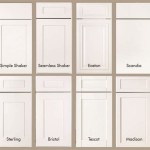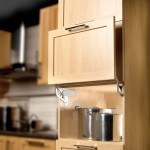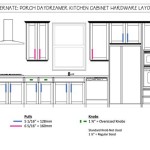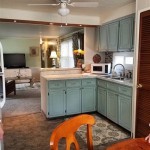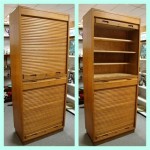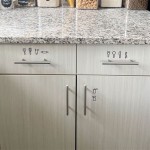White High Gloss Kitchen Unit Doors: A Guide to Aesthetics and Practicality
White high gloss kitchen unit doors have become a popular choice for homeowners seeking a modern and sophisticated aesthetic. Their reflective surface brightens the kitchen, creating an illusion of spaciousness and cleanliness. This article explores the various aspects of white high gloss kitchen unit doors, examining their material composition, advantages, disadvantages, maintenance requirements, and design considerations. Understanding these factors allows for informed decision-making when selecting kitchen cabinetry.
The appeal of white as a color choice for kitchen cabinets lies in its versatility. It seamlessly integrates with a variety of design styles, from minimalist and contemporary to transitional and even some modern farmhouse interpretations. The high gloss finish amplifies this adaptability, adding a touch of glamour and reflecting light to enhance the overall ambiance of the kitchen space. Furthermore, the clean, pristine look of white contributes to a sense of hygiene and order, qualities highly valued in a kitchen environment.
Material Composition and Manufacturing Processes
White high gloss kitchen unit doors are typically constructed from a substrate material, such as medium-density fiberboard (MDF) or particleboard, which is then coated with a high gloss finish. MDF is often preferred due to its smooth surface and resistance to warping, providing an ideal base for achieving a flawless glossy exterior. Particleboard, while less expensive, may require more preparation to ensure a smooth and even finish.
The high gloss finish itself can be achieved through several methods. One common technique involves applying multiple layers of lacquer, each layer being meticulously sanded and polished to create a smooth, reflective surface. Another technique utilizes a high-gloss acrylic or laminate sheet that is bonded to the substrate material using heat and pressure. This process results in a durable and scratch-resistant surface, though repairs to scratches can be more challenging than with lacquered finishes.
Edge banding is another critical aspect of manufacturing high gloss kitchen unit doors. The edges of the doors are typically finished with a matching material – often ABS (Acrylonitrile Butadiene Styrene) or PVC (Polyvinyl Chloride) – to protect the core material from moisture and impact. The quality of the edge banding and its application significantly impact the overall durability and aesthetic appeal of the doors. Poorly applied edge banding can lead to chipping, peeling, and moisture damage, compromising the longevity of the cabinetry.
The selection of hardware, such as hinges and handles, should also be carefully considered. High-quality, durable hardware is essential for ensuring the smooth and reliable operation of the doors. Soft-close hinges are particularly valuable, as they prevent slamming and reduce wear and tear on the doors and cabinets.
Advantages of White High Gloss Kitchen Unit Doors
Several advantages contribute to the popularity of white high gloss kitchen unit doors. Firstly, their reflective surface maximizes light, making the kitchen appear brighter and more spacious. This is particularly beneficial in smaller kitchens or those with limited natural light. The light-reflecting properties can also help to reduce the need for artificial lighting during the day, contributing to energy savings.
Secondly, white is a neutral color that complements a wide range of color schemes and design styles. It provides a blank canvas that allows for the incorporation of other colors and textures through accessories, countertops, and backsplashes. This versatility makes it easy to update the kitchen’s look without replacing the cabinetry. The high gloss finish adds a touch of elegance and sophistication, elevating the overall aesthetic of the kitchen.
Thirdly, the smooth, non-porous surface of high gloss doors makes them relatively easy to clean. Spills and splatters can typically be wiped away with a damp cloth, preventing stains and maintaining the pristine appearance of the cabinets. This ease of cleaning is a significant advantage in a kitchen environment, where spills and messes are common occurrences.
Fourthly, well-manufactured high gloss doors offer a degree of durability. The protective coating, whether lacquer or laminate, provides resistance to scratches, stains, and moisture. This durability contributes to the longevity of the cabinetry, making it a worthwhile investment for homeowners.
Disadvantages and Considerations
Despite their numerous advantages, white high gloss kitchen unit doors also have some drawbacks that need to be considered. One primary concern is the tendency to show fingerprints and smudges. The highly reflective surface readily reveals any marks, requiring more frequent cleaning to maintain a spotless appearance. This can be a significant consideration for families with young children or those who frequently use their kitchens.
Another disadvantage is the potential for scratches. While high gloss finishes are often treated to resist scratches, they are not entirely immune to them. Sharp objects or abrasive cleaners can damage the surface, resulting in visible scratches that detract from the overall appearance. Repairs to scratches can be challenging and may require professional assistance.
The high gloss finish can also be unforgiving in terms of surface imperfections. Any unevenness or flaws in the substrate material will be magnified by the reflective surface, making them more noticeable. This underscores the importance of selecting high-quality materials and ensuring meticulous attention to detail during the manufacturing process.
Furthermore, the bright, reflective surface can sometimes create glare, particularly in kitchens with abundant natural light. This glare can be uncomfortable for some individuals and may require the use of window treatments to mitigate the effect. Thoughtful consideration of the kitchen’s orientation and natural lighting conditions is essential when selecting high gloss cabinetry.
Cost is also a factor to consider. High gloss kitchen unit doors typically cost more than matte or semi-gloss alternatives due to the more complex manufacturing processes and the use of specialized materials. However, the added cost may be justified by the enhanced aesthetic appeal and perceived value that high gloss cabinets bring to the kitchen.
Maintenance and Cleaning
Proper maintenance is crucial for preserving the appearance and longevity of white high gloss kitchen unit doors. Regular cleaning is essential to remove fingerprints, smudges, and spills. A soft, damp cloth is usually sufficient for routine cleaning. Microfiber cloths are particularly effective for removing streaks and smudges without scratching the surface.
Avoid using abrasive cleaners, scouring pads, or harsh chemicals, as these can damage the high gloss finish. Mild dish soap diluted in water is a safe and effective cleaning solution. After cleaning, it is important to dry the doors thoroughly with a clean, dry cloth to prevent water spots.
For more stubborn stains or grease buildup, a specialized high gloss cleaner may be necessary. However, it is essential to test the cleaner in an inconspicuous area first to ensure it does not damage the finish. Follow the manufacturer’s instructions carefully when using any cleaning product.
To prevent scratches, avoid placing sharp objects directly on the surface of the doors. Use placemats or coasters to protect the doors from scratches caused by dishes, utensils, or other items. Be mindful of jewelry or clothing that may scratch the surface when reaching into cabinets.
Regularly inspect the hinges and hardware to ensure they are properly tightened and functioning smoothly. Tighten any loose screws to prevent the doors from sagging or becoming misaligned. Lubricate the hinges periodically to maintain smooth operation and prevent squeaking.
Protect the doors from excessive heat and humidity. Avoid placing hot appliances directly against the doors, as this can cause damage to the finish. Ensure adequate ventilation in the kitchen to prevent moisture buildup, which can lead to warping or delamination of the cabinet doors.
By following these maintenance and cleaning guidelines, homeowners can keep their white high gloss kitchen unit doors looking their best for years to come.

Guide To High Gloss White Kitchen Doors Warehouse

High Gloss Kitchen Cabinets Design By Primehardware Inc

High Gloss Kitchens White Grey Kitchen Units Wren

High Gloss Kitchen Cabinet Doors

White Gloss Kitchen Units Orlando Wickes

High Gloss Kitchen Cabinets Or Matte How To Choose Oppolia

The Pros And Cons Of High Gloss Kitchens

White High Gloss Kitchen Cabinets Diamond Cabinetry

Duleek Gloss White Brown Santana Kitchen Wexkit Wexford

High Gloss Kitchen Cabinets Design By Primehardware Inc
Related Posts

